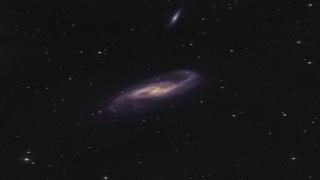Bibcode
Knapen, J. H.; Cisternas, M.; Querejeta, M.
Referencia bibliográfica
Monthly Notices of the Royal Astronomical Society, Volume 454, Issue 2, p.1742-1750
Fecha de publicación:
12
2015
Número de citas
95
Número de citas referidas
82
Descripción
We investigate the influence of interactions on the star formation by
studying a sample of almost 1500 of the nearest galaxies, all within a
distance of ˜45 Mpc. We define the massive star formation rate
(SFR), as measured from far-IR emission, and the specific star formation
rate (SSFR), which is the former quantity normalized by the stellar mass
of the galaxy, and explore their distribution with morphological type
and with stellar mass. We then calculate the relative enhancement of
these quantities for each galaxy by normalizing them by the median SFR
and SSFR values of individual control populations of similar
non-interacting galaxies. We find that both SFR and SSFR are enhanced in
interacting galaxies, and more so as the degree of interaction is
higher. The increase is, however, moderate, reaching a maximum of a
factor of 1.9 for the highest degree of interaction (mergers). The SFR
and SSFR are enhanced statistically in the population, but in most
individual interacting galaxies they are not enhanced at all. We discuss
how those galaxies with the largest SFR and/or SSFR enhancement can be
defined as starbursts. This study is based on a representative sample of
nearby galaxies, including many low-mass and dwarf/irregular galaxies,
and we argue that it should be used to place constraints on studies
based on samples of galaxies at larger distances, beyond the local
Universe.
Proyectos relacionados

Las Galaxias Espirales: Evolución y Consecuencias
Nuestro grupo pequeño esta bien conocido y respetado internacionalmente por nuestro trabajo inovativo e importante en varios aspectos de la estructura y la evolución de las galaxias espirales cercanas. Usamos principalmente observaciones en varias longitudes de onda, explotando las sinergías que nos permiten responder a las cuestiones más
Johan Hendrik
Knapen Koelstra